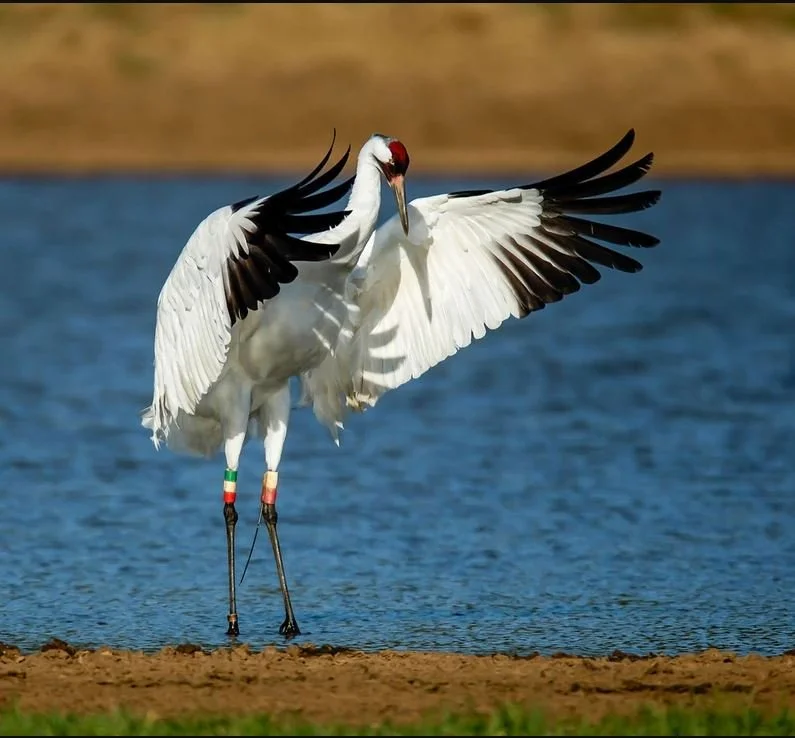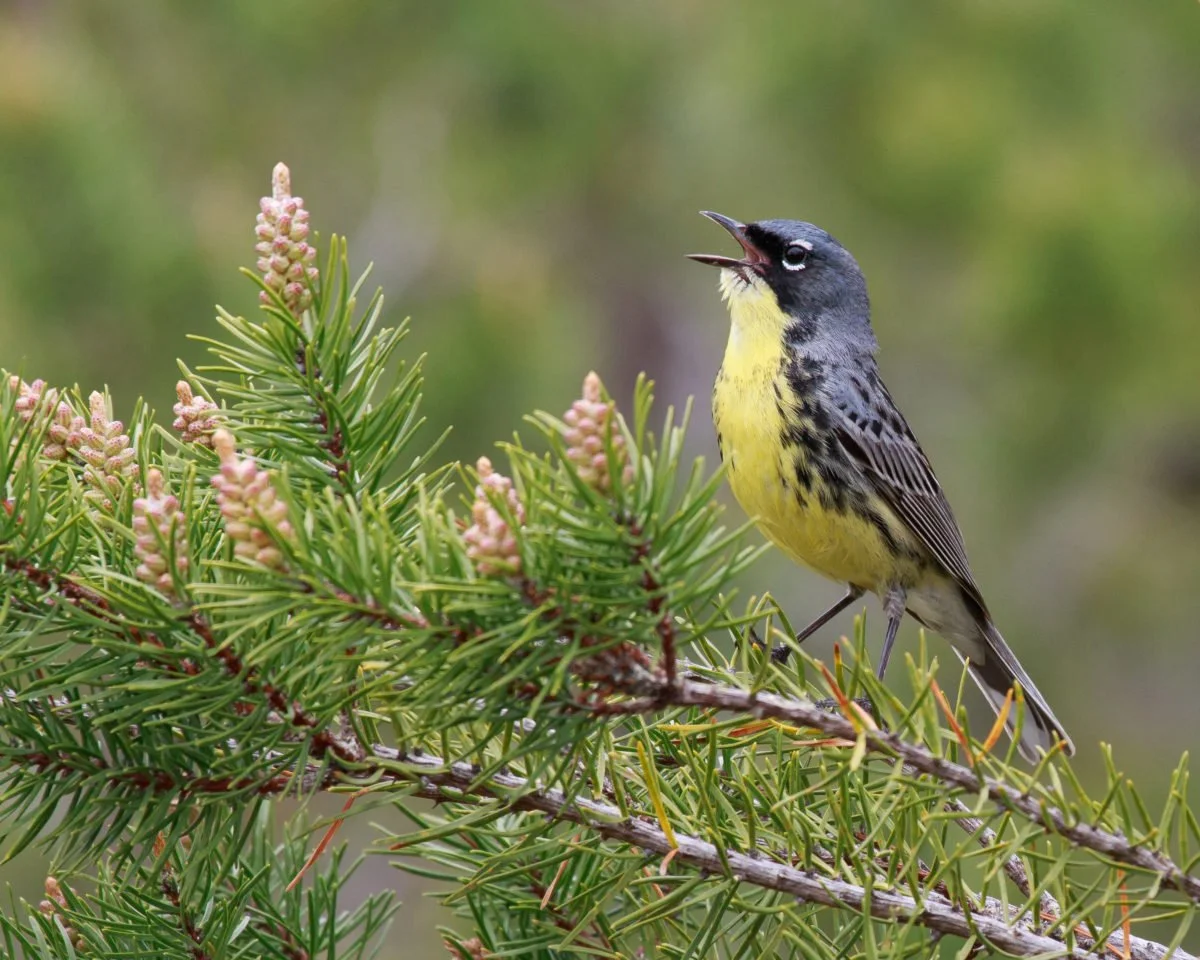How the Endangered Species Act Saves Birds
By Terry Rich, Golden Eagle Guest Blogger
The Endangered Species Act (ESA) is celebrating its 50th anniversary on December 28, 2023. It was enacted in 1973 to prevent the loss of wildlife and plant species and to preserve the habitats they require. The ESA has been effective in saving nearly 99 percent of the plant and animal species it protects.
In today’s politically divided world, it’s almost impossible to imagine how conservation organizations, state wildlife agencies, and the federal government came together to pass this law. The bill passed by a vote of 92-0 in the Senate and 355-4 in the House. Imagine!
Whooping Crane by Karen Wiles
And, incredibly, it was Republican Richard Nixon who signed the ESA into law. Nixon wrote,
“Nothing is more priceless and more worthy of preservation than the rich array of animal life with which our country has been blessed. … America will be more beautiful in the years ahead, thanks to the measure that I have the pleasure of signing into law today.”
For those of us who were there, we had already seen the passage of the Clean Air Act (1963), Wild and Scenic Rivers Act (1968), National Environmental Policy Act (1970), and Clean Water Act (1972). It seemed that our society had finally recognized the damage we were doing to the planet and taken serious steps to address it. We were on a good track for maintaining, restoring, and protecting natural resources and the millions of other species we share the planet with.
Non-Stop Slug Fest
But it’s been a non-stop slug fest since the ESA was passed, as developers of all sorts continue to exploit natural resources, often with less regard for the environment than we need. Without these acts, and a few that came later, such as the Federal Land Policy and Management Act (1976), legal defense teams, and overwhelming public support, we would not have the conservation world we have today. It’s not ideal, but it’s pretty good.
The ESA arena is big and complex. The Act currently protects 1,662 U.S. species and 638 foreign species. The goal is to “recover” these species and get them off these lists. But recovery varies between difficult and nearly impossible. Experts have to know the biology of a species well, know what the limiting factors are, figure out what conservation actions are needed, and then decide when and where to take those actions. Each of these bits can take years of research and monitoring to figure out.
People, Funding and Politics Impede Recovery
But that’s just the biological part. They also have to muster the people and funding – from both public and private partners – to take the actions. Conservation is seriously underfunded at all levels. Thus, practitioners must continually apply triage, having to prioritize even among the most needy species. Only a small fraction of needs will be met in any given year.
Finally, endangered species advocates have to navigate political, legal, and bureaucratic mazes to make it happen. The U.S. Fish and Wildlife Service (USFWS) employs around 1,800 biological experts to work on threatened and endangered species and related support issues. Other federal agencies, state agencies, and conservation organizations also have staff for this work.
As a result of these complexities and challenges, only 54 species in the U.S. have been delisted due to Recovery. Delisting can happen for other reasons – extinction and taxonomic changes, for example – but Recovery is what we want. Recovery means that the number, distribution, and sizes of populations, for example, have met the goals established in the species’ Recovery Plan. If you are curious about these plans, check them out at https://ecos.fws.gov/ecp/report/species-with-recovery-plans. Assembling a Recovery Plan is also a complex and time-consuming task, involving not only the USFWS, but also countless partners with various skills and interests.
How Has This Worked for the Birds?
10 bird species or populations in the U.S. have been recovered.
Bald Eagle
American Peregrine Falcon
Arctic Peregrine Falcon
Kirtland’s Warbler
Black-capped Vireo
Brown Pelican
Aleutian Canada Goose
San Clemente Sage Sparrow
Least Tern
'Io (Hawaiian Hawk)
Kirtland’s Warbler by Michigan Audubon
Bald Eagle and Peregrine Falcon Recovery
There is no greater symbol for the effectiveness of the ESA than the Bald Eagle. A critical piece of this story was that a key limiting factor was identified – DDT – and then countless actions were taken to eliminate it. In the Lower 48 states, Bald Eagles increased from 417 nesting pairs in 1963 to 71,467 individual birds in 2020 – an absolutely stunning increase!
This is a great example of how species can rebound, if we just give them a chance. Stop poisoning them, stop destroying their habitat, stop shooting them, keep cats indoors, and do more to prevent all sorts of collision hazards. Note that Bald Eagles still have more protection than most migratory birds (Migratory Bird Treaty Act) due to the Bald and Golden Eagle Protection Act.
A species conservation success story that is probably even more revered among ornithologists is the Peregrine Falcon. As with the Bald Eagle, DDT was the main villain. Once that threat was addressed, partners were not content to just wait for peregrines to recover themselves. The Peregrine Fund (TPF) was created by Cornell ornithology professor Tom Cade in 1970 to save these falcons – the fastest species on earth – from extinction.
Peregrine Falcon by Greg Gard
TPF pioneered many techniques through the years for successfully breeding birds in captivity and releasing them into the wild. They bred and released more than 4,000 falcons from 1974 to 1997. It’s important to understand that these thousands of falcons weren’t just tossed out of a car window and wished good luck. They were all hacked. “Hacking” is the controlled release of young falcons from a hack box to house and feed young birds during the preflight period. Those birds are then typically fed after fledging and monitored until they are independent. Hacking requires a knowledgeable team of people for weeks.
Peregrine Falcons increased from a low of 324 pairs in the U.S. in 1975 to an estimated population of 72,000 in the U.S. and Canada in 2020. The peregrine was delisted in 1999. TPF headquarters have been at the World Center for Birds of Prey right here in Boise since 1984. TPF has since used its knowledge and resources to help conserve many other species of birds of prey, such as the California Condor, Harpy Eagle, Aplomado Falcon, and Puerto Rican Sharp-shinned Hawk.
I could go on for pages, just touching on the highlights of what went into getting these other birds delisted. Each species is unique, with its own biology, threats, research needs, and proposed conservation actions. You can find Species Reports, Conservation Plans, and many other resources at the USFWS’s Environmental Conservation Online System (https://ecos.fws.gov/ecp/).
What the record shows me is that when we focus our scientific and political resources, we can be successful in bird conservation. To get more species recovered faster will require more funding. And, as conservationists have said for decades, it’s best to conduct broad conservation measures ahead of time, across all ecosystems, so that we don’t have to list species in the first place.
You can reach Terry at terryrichbrd@gmail.com
California Condor by Brad Quicksall



